
Back to the Home page
Species lists below

Eight members attended this mid-summer afternoon meeting which concentrated on a clear fell site just north of Spiers House campsite. This clearing of approximately 200m × 400m was the site of a fire about five years ago which destroyed all the vegetation. This meeting was primarily to discover how the flora and fauna had regenerated thus far. Members approached the site along an access road and it was a delight to see so many common spotted orchids in the verge. There were also two large spreads of betony near the carpark. Yellow rattle was common alongside all the tracks.
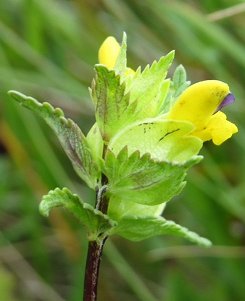 Yellow rattle Rhinanthus minor |
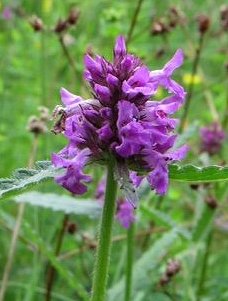
Betony (detail) Stachys officinalis |
Botanically the area has recovered well with 61 species recorded not including grasses and trees. There were plenty of well-established conifer saplings which presumably have been planted. Bell heather was the dominant heath species but there were odd small clumps of ling and cross-leaved heath. We were able to cross part of the area via a footpath but otherwise the ground was very uneven. It appeared well drained but there was a wet ditch alongside the path. The area was surrounded on three sides by well-established forest and the main access track on the fourth side. These track sides allow for a further variety of flora, including common centuary, ox-eye daisy, St John’s wort and wild marjoram amongst others.
 Centaury Centaurium erythraea |
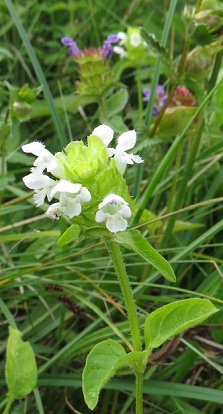
Self heal (white form) Prunella vulgaris |
Having studied the main area the group headed northwest along a deep rutted track through the forest to another much larger clear fell site and back to the carpark via a main access track. This last track yielded an abundance of rather good wild strawberries. It was along this trackside that a white form of self heal was seen, just two stems.
Birds were not in any great numbers and as expected we did see tree pipits, still feeding young in one instance. One member visited this site on the previous evening and at least one nightjar was churring.
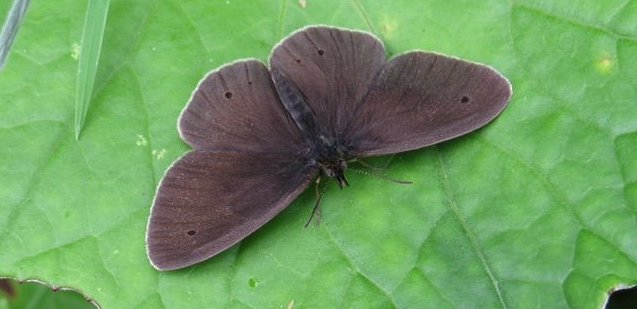
Ringlet butterfly
The predominant butterfly was ringlet in good numbers but there were low numbers of the others listed with only single sightings of small skipper, speckled wood and common blue. One fritillary was seen but too brief a glimpse to identify. Other insects included a “bottley blue bee” that turned out to be the parasitic tachind fly Tachina grossa and the wasp-mimicking hoverly Sericomyia silentis (ironically named as it flies with a very loud buzz). [
Ed: Thanks to Stuart Dunlop for the IDs.]
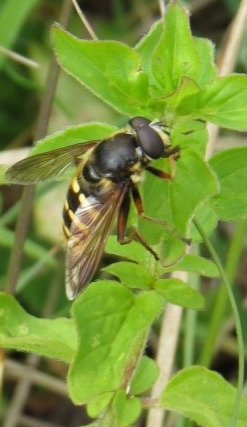 Hoverfly Sericomyia silentis |
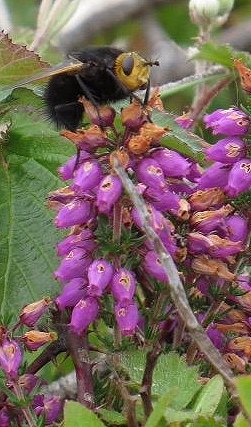
Parasitic tachinid fly Tachina grossa |
Note: most grasses are not on this list.
| Latin name | English name |
|---|---|
| Achillea millefolium | Yarrow |
| Alchemilla sp. | Lady’s mantle |
| Bellis perennis | Daisy |
| Blechnum spicant | Hard fern |
| Briza media | Quaking grass |
| Calluna vulgaris | Ling |
| Carex echinata | Star sedge |
| Carex panicea | Carnation sedge |
| Carex viridula = C. demissa | Yellow sedge |
| Centaurea nigra | Common knapweed |
| Centaurium erythraea | Centaury |
| Cirsium arvense | Creeping thistle |
| Cirsium palustre | Marsh thistle |
| Cirsium vulgare | Spear thistle |
| Cruciata laevipes | Crosswort |
| Dactylis glomerata | Cocksfoot |
| Dactylorhiza fuchsii | Common spotted orchid |
| Deschampsia caespitosa | Tufted hairgrass |
| Digitalis purpurea | Foxglove |
| Dryopteris dilatata | Common or broad buckler fern |
| Dryopteris filix-mas | Male fern |
| Equisetum arvense | Field horsetail |
| Equisetum sylvaticum | Wood horsetail |
| Erica cinerea | Bell heather |
| Erica tetralix | Cross-leaved heath |
| Euphrasia officinalis agg. | Eyebright |
| Fragaria vesca | Wild strawberry |
| Heracleum sphondylium | Hogweed |
| Hypericum perforatum | Perforate St Johnswort |
| Hypericum pulchrum | Beautiful or Slender St Johnswort |
| Juncus conglomeratus | Compact rush |
| Leucanthemum vulgare | Dog daisy or Ox-eye daisy |
| Linum catharticum | Fairy flax |
| Lotus corniculatus | Common birdsfoot trefoil |
| Matricaria discoidea | Pineapple weed |
| Medicago lupulina | Black medick |
| Myosotis discolor | Changing forgetmenot |
| Oreopteris limbosperma | Lemon-scented Fern |
| Origanum vulgare | Marjoram |
| Plantago lanceolata | Ribwort plantain |
| Plantago major | Ratstail plantain |
| Potentilla anserina | Silverweed |
| Potentilla erecta | Tormentil |
| Potentilla reptans | Creeping cinquefoil |
| Prunella vulgaris | Self heal |
| Pteridium aquilinum | Bracken |
| Ranunculus acris | Meadow buttercup |
| Ranunculus repens | Creeping buttercup |
| Rhinanthus minor | Yellow rattle |
| Rubus fruticosus | Bramble |
| Senecio jacobea | Common ragwort |
| Sonchus asper | Prickly sowthistle |
| Stachys officinalis = Betonica officinalis | Betony |
| Stachys sylvatica | Hedge woundwort |
| Torilis japonica | Upright hedge parsley |
| Trifolium pratense | Red clover |
| Trifolium repens | White clover |
| Tussilago farfara | Coltsfoot |
| Urtica dioica | Nettle |
| Vaccinium myrtillus | Bilberry |
| Veronica chamaedrys | Germander speedwell |
| Vicia cracca | Tufted vetch |
Bullfinch, Greenfinch, Siskin, Swallow, Tree Pipit, Wren, Woodpigeon, Carrion Crow and Nightjar on the previous evening.
Pardosa pullata, Enoplognatha ovata, Linyphia triangularis.
Ringlet, Small Tortoiseshell, Speckled Wood, Common Blue, Small Skipper, Meadow Brown and unidentified fritillary.
Large Yellow Underwing.
Tachina grossa, Sericomyia silentis and Ampedus balteatus (a click beetle). Thanks to Stuart Dunlop for IDs.
| © Ryedale Natural History Society 2015, Photos © RNHS and Jayne Smith 2015 |